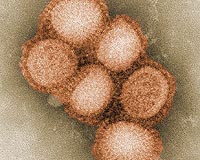| . |  |
. |
Geneva (AFP) Aug 23, 2009 The World Health Organisation is urging the planet to brace for a second wave of the swine flu pandemic as the heavily populated northern hemisphere edges towards the cooler season when flu thrives. "The WHO is still mobilised and worried," spokesman Gregory Hartl said as the global health watchdog kept an anxious eye on some "mysterious" patterns of illness associated with the new A (H1N1) virus that appeared in April. Influenza traditionally surges to its peak during the northern autumn and winter. WHO Director General Margaret Chan warned on Friday that there had been second and third waves in previous pandemics. "We cannot say for certain whether the worst is over or the worst is yet to come," Chan said in a videotaped address to a symposium on flu in the Asia-Pacific region. "We need to be prepared for whatever surprises this capricious new virus delivers next," she added. Some 1,799 people have died since the A(H1N1) was uncovered in Mexico and the United States nearly six months ago, according to the UN health agency. By comparison, an estimated 250,000 to 500,000 people die around the world every year from seasonal flu, and overall the symptoms of the new pandemic virus have proved to be mild in the great majority of known cases. However, it has spread swiftly into 177 countries, proving to be more infectious than seasonal flu and more durable through warmer months. Through a full season in the southern hemisphere, the pandemic strain gradually became dominant. WHO monitoring showed that it was now on the decline there, except in South Africa, and in some later affected areas of Argentina, Australia and Chile. Some 182,000 people worldwide are known to have caught swine flu based on laboratory confirmed cases, but the WHO has long advised countries to give up counting; the true number may in the millions, according to some experts. It is also striking those in a more physically fragile phase of life, such as pregnant women or the chronically ill, as well as those who are obese and younger age groups than usual. Many of the most severe cases are among 30 to 50 year-olds. WHO officials are also mystified at the "most worrying" characteristic of this flu virus, Hartl explained. About 40 percent of the most severe or fatal cases occur in people who are in perfect health, he told AFP. However, he was unable to say how many severe cases had occurred, although they are generally regarded as a small proportion of the outbreak so far. With autumn approaching, northern countries have set emergency flu plans into motion, in some instances before the WHO's long heralded formal declaration of a pandemic on June 11 that marked global spread of the virus. While that includes many of the wealthiest nations -- with the most medicines, access to key antiviral drugs and vaccine development, as well as the best health care -- Hartl pointed out that the hemisphere also includes five-sixths of the world's population. More than one billion doses of preventive vaccine have been ordered by those countries. But the vaccine is not expected to be ready for use until October and will only be available gradually, for the most vulnerable groups and health workers first. The WHO has cut its estimate of maximum annual production capacity of 4.9 billion vaccines, currently focusing on about half or even one quarter of that amount. It is still unclear whether one or two doses will be necessary. In the meantime, plans to mobilise stockpiles of antiviral drugs such as Tamiflu, reinforce health care capacity and close down schools temporarily to limit the spread of infection have already been tested in the first wave. Hartl said it was impossible to rule out the resurgence of A (H1N1) before October to November, the more usual period for the growth in seasonal influenza. "Everyone must be ready," said the WHO spokesman. "It is already amongst us, as we saw this summer." Share This Article With Planet Earth
Related Links Epidemics on Earth - Bird Flu, HIV/AIDS, Ebola
 Swine flu looms over global economic recovery
Swine flu looms over global economic recoveryWashington (AFP) Aug 23, 2009 The markets have begun to pop champagne over global economic recovery, but the elephant lurking in the room -- swine flu -- could trample those green shoots. Spotted just four months ago, the new A(H1N1) influenza virus spread by June into a global pandemic and experts warn it could take a toll on productivity and financial systems, depending on the severity of outbreaks. About 1,800 ... read more |
|
| The content herein, unless otherwise known to be public domain, are Copyright 1995-2009 - SpaceDaily. AFP and UPI Wire Stories are copyright Agence France-Presse and United Press International. ESA Portal Reports are copyright European Space Agency. All NASA sourced material is public domain. Additional copyrights may apply in whole or part to other bona fide parties. Advertising does not imply endorsement,agreement or approval of any opinions, statements or information provided by SpaceDaily on any Web page published or hosted by SpaceDaily. Privacy Statement |